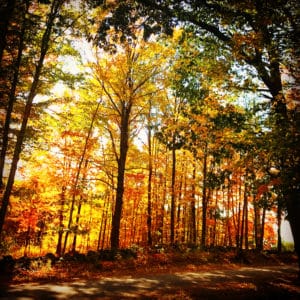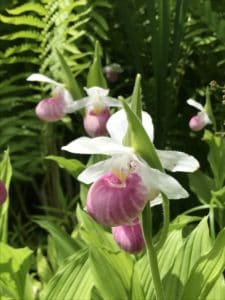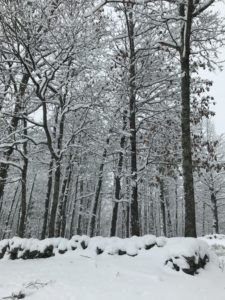When I was a very young woman, I heard a writer say that when you set a story in a given place, you should be able to name every bird, every tree, every flower in that setting. I remember thinking, “Uh oh.” As an Army brat who moved at least once a year, I barely got to know the streets around our quarters, much less anything else. That said, I spent most of my childhood outside, skipping stones into the creek at the bottom of the bluff where Geronimo leapt on horseback, reading Nancy Drew mysteries perched in apple trees in German orchards, walking in the woods of southern Indiana with my father and the dogs. But I couldn’t name many birds or trees or flowers, apart from the ubiquitous robins and oaks and roses.

Many years later, I moved to New England, and for the first time in my life I lived in the same place long enough to learn the backroads, and grow a garden, and put names to the flora and fauna around me. In my Mercy Carr series, set primarily in the Vermont wilderness, I draw upon nature not just for setting, but for character and plot and inspiration as well. I’ve learned to write about nature, well enough to appeal to readers and reviewers alike. Here are some of the tips I’ve picked up along the way.
“You can know the name of a bird in all the languages of the world, but when you’re finished, you’ll know absolutely nothing whatever about the bird… So let’s look at the bird and see what it’s doing … I learned very early the difference between knowing the name of something and knowing something.”
― Richard P. Feynman
It’s hard to write authentically about nature if you never leave the house. Even the reclusive Emily Dickinson walked the meadows and woods and orchards of the family estate, in addition to her flower and vegetable gardens. (The amazing Elisabeth Tova Bailey, author of The Sound of a Wild Snail Eating, is the exception that proves the rule.)
Get out there and get your hands dirty, your boots muddy, your hair messy. Not only for the sake of writing setting, but for the sake of writing character as well. My heroine Mercy Carr and her canine companion Elvis both escape to the Green Mountains of Vermont for long hikes that quiet their minds and engage their bodies and soothe their souls—a respite that helps them deal with the aftermath of their deployments in the Middle East. Mercy’s love of nature is an essential part of her make-up, one that informs her life and her work.

One of the glories of living and writing in New England is that I’ve got a front row seat to the changing of the seasons, year in and year out—which inspired me to set each book in my series in a different season. Between nearby woods and wildlife, meadows and marshland, streams and rivers and lakes, I don’t have to go very far for inspiration. I hope you don’t, either.
But even if you live in the city, nature is just a park away. Or, at worst, a (short) road trip away. You can use apps like Picture This and BirdNET to help you identify plants and birds in the field or in your garden. And you can use your cell phone to snap photos of anything you don’t recognize, from bear scat to species of snakes. Post them on social media, and someone somewhere will know what it is. Not to mention the park rangers, game wardens, biologists, botanists, and all manner of experts who in my experience are always happy to talk to writers.
I love venturing out in search of Mother Nature. (And right now it’s safer outside, as we’ve learned the hard way.) I’ve been to Eshqua Bog to see the annual June blooming of the lady’s slipper orchids, ridden the foliage train through the annual blaze of autumnal splendor, snow-shoed through the quiet world of winter woods, hiked the cool and damp mountain trails in spring. I’ve gone whale watching on the ocean, kayaking on bays and sloughs, and paddle-boarding on lakes large and small. I’ve spotted bald eagles and barred owls and great blue herons and attended lectures delivered by bear project leaders and raptor researchers and forest biologists.
And that’s just here in New England. When I travel, I make sure to include visits to the local nature sites as well as the usual tourist destinations. I’m not going too far afield these days, but in the meantime I’m keeping a wish list for future travel. Make a bucket list of the wild places you’d most like to see.

“Nature writing, if such a thing exists, lives in this territory where science and poetry might meet. It must be made of both; it needs truth and beauty.”
― Tim Dee
Read the best nature writers: Poets and essayists, gardeners and adventurers, novelists and memoirists. I read widely in the nature writing genre, for my own entertainment and edification but also as a reminder that paying attention is a critical aspect of good writing. The best writers in this field are by definition masterful observers of the natural world.
This is really fun homework. Here’s a (wildly incomplete) list of some of the writers (and works) who have changed the way I think about the natural world and our place in it:
- Refuge, by Terry Tempest Williams
- Pilgrim at Tinker’s Creek, by Annie Dillard
- Walden, by Henry David Thoreau
- The Walker’s Guide to Outdoor Clues & Signs, by Tristan Gooley
- The Old Ways, by Robert Macfarlane
- The Hidden Life of Trees, by Peter Wohlleben
- Braiding Sweetgrass, by Robin Wall Kimmerer
- Animal, Vegetable, Miracle, by Barbara Kingsolver
- My Garden (Book), by Jamaica Kincaid
- The poems of Mary Oliver, Emily Dickinson, Joy Harjo, John Clare, Anne Spencer, Donald Hall, Robert Frost, Pablo Neruda, Basho, Fukuda Chiyo-ni, and so many more….
“I don’t know if nature is a direct literary influence on my writing, but it is certainly important to me. I take great joy in writing about it. It is something I have taken with me from my childhood; the body exposed to the threat of the physical world and at the same time being at home in it.”
― Per Petterson
Much of what I encounter in the physical world, as Petterson puts it, finds its way into my novels, one way or another, sooner or later. That includes both the pleasures and the perils of the great outdoors: wild orchids and wild blueberries and wild turkeys, howling winds and rising creeks and breaking ice, snow and hail and thunder and lightning, bears attacking and moose charging and—most dangerous of all—humans being human.
Mother Nature can be a writer’s best friend. In the natural world, you’ll find endless possibilities for revealing your characters, propelling your plots, and supercharging your settings. All you have to do is look.






